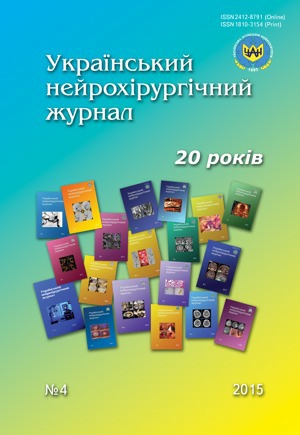Brain abscess: analysis of 242 clinical cases
DOI:
https://doi.org/10.25305/unj.55963Keywords:
brain abscess, etiology, surgical treatmentAbstract
Objective: To study the results of surgical treatment and etiopathogenic characteristics of brain abscesses.
Materials and methods: 242 cases of brain abscesses were analyzed. The age of patients ranged from 1 month to 74 years, the average age of 36,5±13,8. The ratio of male/female was 2.1 to 1.
Results: In the treatment of patients prevailed tactics of surgical treatment in combination with antibiotic therapy. Of the 242 patients operated on 233 (96.3%), not operated on — 9 (3.7%). Mortality in the group of operated patients was 55.6%. Postoperative mortality is 12,4%. The following types of surgical interventions: total removal — 48.5%, drainage of abscess — 34.3%, the puncture technique “by hand” — 6.4%, neuronavigation techniques — 9%, a combined method of treatment - 3%. Bacteriological examination of the contents of the abscess were carried out at all operated patients . Height was obtained in 58 (24.9%) cases.
Conclusions: To speed up the verification process of the pathogen need to use the entire range of laboratory techniques. The choice of surgical treatment must take into account the particular preferences of the neurosurgeon and operating equipment. According to our data, the most appropriate methods of surgical treatment were: stereotactic techniques and total removal of abscess.
References
1. Bernardini GL. Diagnosis and management of brain abscess and subdural empyema. Curr Neurol Neurosci Rep. 2004 Nov;4(6):448-56. [CrossRef] [PubMed]
2. Sharma BS, Gupta SK, Khosla VK. Current concepts in the management of pyogenic brain abscess. Neurol India. 2000 Jun;48(2):105-11. [PubMed]
3. Leuthardt EC, Wippold FJ 2nd, Oswood MC, Rich KM. Diffusionweighted MR imaging in the preoperative assessment of brain abscesses. Surg Neurol. 2002 Dec;58(6):395-402. [CrossRef] [PubMed]
4. Calfee DP, Wispelwey B. Brain abscess. Semin Neurol. 2000;20(3):353-60. [CrossRef] [PubMed]
5. Kao PT, Tseng HK, Liu CP, Su SC, Lee CM. Brain abscess: clinical analysis of 53 cases. J Microbiol Immunol Infect. 2003 Jun;36(2):129-36. [PubMed]
6. Karasu A, Cansever T, Sabanci PA, Kiriş T, Imer M, Oran E, Sencer A, Unal F. Craniocerebral civilian gunshot wounds: one hospital’s experience. Ulus Travma Acil Cerrahi Derg. 2008 Jan;14(1):59-64. [PubMed]
7. Xiao F, Tseng MY, Teng LJ, Tseng HM, Tsai JC. Brain abscess: clinical experience and analysis of prognostic factors. Surg Neurol. 2005 May;63(5):442-9. [CrossRef] [PubMed]
8. Erdogan E, Izci Y, Gonul E, Timurkaynak E. Ventricular injury following cranial gunshot wounds: clinical study. Mil Med. 2004 Sep;169(9):691-5. [CrossRef] [PubMed]
9. Mamelak AN, Mampalam TJ, Obana WG, RosenblumML. Improved management of multiple brain abscesses: a combined surgical and medical approach. Neurosurgery. 1995 Jan;36(1):76-85. [CrossRef] [PubMed]
10. Hall WA, Truwit CL. The surgical management of infections involving the cerebrum. Neurosurgery. 2008 Feb;62(2):519-30. [CrossRef] [PubMed]
11. Ratnaike TE, Das S, Gregson BA, Mendelow AD. A review of brain abscess surgical treatment-78 years: aspiration versus excision. World Neurosurg. 2011 Nov;76(5):431-6. [CrossRef] [PubMed]
12. Cavuşoglu H, Kaya RA, Türkmenoglu ON, Colak I, Aydin Y. Brain abscess: analysis of results in a series of 51 patients with a combined surgical and medical approach during an 11-year period. Neurosurg Focus. 2008;24(6):9. [CrossRef] [PubMed]
13. Gadgil N, Patel AJ, Gopinath SP. Open craniotomy for brain abscess: a forgotten experience? Surg Neurol Int. 2013 Mar 25;4:34. [CrossRef] [PubMed]
14. Roche M, Humphreys H, Smyth E, Phillips J, Cunney R, McNamara E, O'Brien D, McArdle O. A twelve-year review of central nervous system bacterial abscesses; presentation and aetiology. Clin Microbiol Infect. 2003 Aug;9(8):803-9. [CrossRef] [PubMed]
15. Greenberg MS. Neyrohyrurgiya [Neurosurgery]. Moscow: MEDpress-inform; 2010. Russian.
16. Hakan T. Management of bacterial brain abscesses. Neurosurg Focus. 2008;24(6):4. [CrossRef] [PubMed]
17. Gilbert D, Mellering R, Eliopus J, Chembers G, Saag M. Spravochnik Senforda po protivomikrobnoy terapii [Sanford Guide for antimicrobial therapy]. Kiev: Ukr. Med. Vestn.; 2013. Russian.
Downloads
Published
How to Cite
Issue
Section
License
Copyright (c) 2015 Yuriy Yasharov, Vitaliy Tsymbaliuk, Irina Tkachik

This work is licensed under a Creative Commons Attribution 4.0 International License.
Ukrainian Neurosurgical Journal abides by the CREATIVE COMMONS copyright rights and permissions for open access journals.
Authors, who are published in this Journal, agree to the following conditions:
1. The authors reserve the right to authorship of the work and pass the first publication right of this work to the Journal under the terms of Creative Commons Attribution License, which allows others to freely distribute the published research with the obligatory reference to the authors of the original work and the first publication of the work in this Journal.
2. The authors have the right to conclude separate supplement agreements that relate to non-exclusive work distribution in the form of which it has been published by the Journal (for example, to upload the work to the online storage of the Journal or publish it as part of a monograph), provided that the reference to the first publication of the work in this Journal is included.









